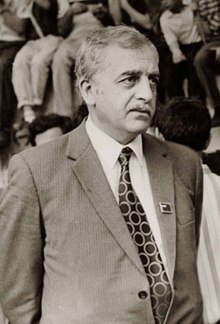Pan-Caucasianism
Historically popular during the Russian Civil War[citation needed], pan-Caucasianism has formed a part of the foreign policy of Georgia[1][dubious – discuss] and Chechen militants since the dissolution of the Soviet Union.
In the 1990s, Georgian President Zviad Gamsakhurdia favored regional alliance between native peoples of the Caucasus; however, he was soon overthrown, so the "realisation of the idea of Caucasianness...has never gone beyond the declaratory level or imaginative projects..."[2] The medieval Kingdom of Georgia has sometimes been described as a pan-Caucasian empire.
Niko Nikoladze envisaged the creation of a free, decentralized, and self-governing federation of the Caucasian peoples based on the principle of ethnically proportional representation.
The Transcaucasian Democratic Federative Republic was established on 22 April 1918 to effectively respond to the Ottoman invasion of the South Caucasus amid the collapse of the Russian empire.
With the February and October Revolutions and the subsequent collapse of the central Russian authority in the Caucasus, the region was left in limbo; the Transcaucasian Commissariat was formed by representatives of Georgia, Azerbaijan and Armenia as a provisional self-government.
On 28 May 1918, Transcaucasian Democratic Federative Republic was dissolved after Georgia declared independence due to irreconcilable foreign policy orientations with other Caucasus states.
It originated from the consolidation of various ethnic groups in North Caucasus, including the Circassians, Chechens, Karachays, Ossetians, Balkars, Ingush, and Dagestanis.
Alexander Nikuradse, a Georgian adviser to Alfred Rosenberg, argued for a German-aligned and Georgian-led independent Caucasian confederation, based on the Karl Haushofer's theories of "large spaces".
According to Nikuradse, Georgia had the same role to the Caucasus that Germany had to Europe: geographically centrally located, racially the purest, politically the most endowed with a mission of leadership.
In Georgia, pan-Caucasian sentiments manifested themselves most strongly under President Zviad Gamsakhurdia, who sought a political, military, and economic alliance between Georgians, Chechens, Abkhazians, and Circassians based on the idea of shared Ibero-Caucasian languages and common identity among autochthonous Caucasian nations.
[2] Georgian President Eduard Shevardnadze advocated for regional cooperation between Georgia, Armenia, Azerbaijan, and Russia in a more diminished form of a "Peaceful Caucasus Initiative".
[11] Chechen President Dzhokhar Dudayev also shared pan-Caucasian views with Zviad Gamsakhurdia, and this allegiance formed a pivotal basis for the concept of a "Caucasian Home".
This group, succeeding President Dzhokhar Dudayev's secular brand of Chechen nationalism, later morphed into an Islamist faction led by Basayev, Anzor Astemirov, and Movladi Udugov.




